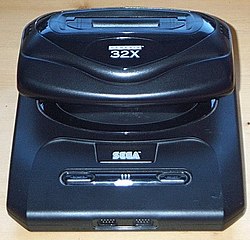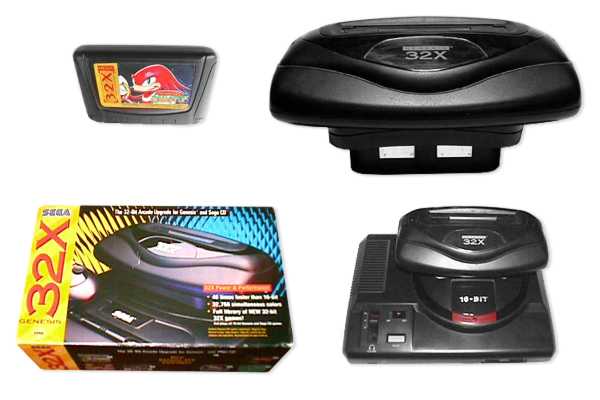The Sega 32X (
Japanese: スーパー32X) is an add-on for the
Sega Mega Drive/Sega Genesis video game console by
Sega.
In
Japan, it was distributed under the name Sega Super 32X. In
North America, its name was the Sega Genesis 32X. In
Europe,
Australia, and other countries that use
PAL, it was called the Sega Mega Drive 32X. Most gamers, for simplicity's sake, refer to it as just the "32X".
Market history
With the release of the
Super Famicom in
Japan and the
Super NES in
North America, Sega needed to leapfrog
Nintendo in the technological department. The Sega Mega-CD, known as
Sega CD in North America, had not worked as well, in a business sense, as Sega had wanted it to. Sega had various developments underway, named after planets. Some used
System 16 technology, as the
Sega Mega Drive/Sega Genesis, as well as other arcade games, did.
The 32X was released in mid-November 1994 in North America for $150, Japan on December 3rd 1994 for ¥16,800, and Europe in January 1995 for £170 /
DM 400.
Technical aspects
The Sega 32X can only be used in conjunction with a Mega Drive/Genesis system; it is plugged in where the cartridge bay is. Besides playing its own cartridges, it also acts as a passthrough for Mega Drive games so it can be a permanent attachment. (The
SVP based
Virtua Racing was the only exception.) The 32X came with several spacers so it would work with all (then current) versions of the Mega Drive. (The Genesis 3, which lacks circuitry needed, and appropriate plugs, to work with the 32X, was introduced later.) It could be used with the
Sega Multi-Mega/Sega CDX system, but the spacers would not accommodate the CDX, which created a number of user-unfriendly conditions in the unit. Without the use of the spacers, some of the 32X hardware was left exposed and vulnerable. The combined unit was also very prone to tipping over, risking damage to the unit and games. In addition to the physical problems, there was also an issue with FCC approval.
Most 32X games cannot be played unless the distribution region of the game matches the region of the console. A few games are not locked and can be played on a console from any region (e.g. Fifa 96). Two games, Darxide and
FIFA Soccer '96, were only released for the PAL 32X.
All but one of the games released for the Japanese market were released in the United States, albeit some had different names. The one Japanese-only game was Sangokushi IV (known as "Romance of the Three Kingdoms IV").
In addition to regular cartridge-based 32X games, there were also a very small number 32X CD games. As the name suggests, these required both the 32X and Mega-CD/Sega CD addons. The lack of a significant userbase due to the high cost of purchasing all three necessary components saw only five games released, only one of those developed by Sega. The most notable of these was a new version of the infamous
Night Trap with 32,768 onscreen colors instead of the 64 found on the regular Mega-CD/Sega CD version.
Technical specifications
Processor: Twin
SH2 32 bit RISC processors with a clock speed of 23 MHz, 40 MIPS each
Video RAM: Two linear framebuffers with support for RLE compression and an overdraw mode to simplify compositing objects with transparency. All scaling, rotation, and 3D operations are performed in software on the SH2 processors.
Color depth: 32,768 simultaneous colors on screen at standard Mega Drive/Genesis resolution. Video output can overlay Mega Drive/Genesis graphics or vice versa. Mega Drive/Genesis video effects such as shadow or hilight do not affect 32X video.
Memory: 256KB (2 MBit) program RAM and two 128KB (1 MBit) framebuffers.
Audio: Stereo 10-bit PWM (Pulse Width Modulation) mixing with Mega Drive/Genesis sound for a total of 12 audio channels of varying capability, 22 with the addition of a Mega-CD/Sega CD.
I/O: Same as Mega Drive/Genesis.
Storage: 32X cartridges are fundamentally the same as Mega Drive/Genesis cartridges with some small differences in the plastic casing. A few CD-ROM games were developed that also required a Mega-CD/Sega CD.
Compatibility: Compatible with Mega Drive/Genesis models 1 and 2, JVC
Wondermega/X'Eye and the
Multi-Mega/CDX. The 32X does not work with the Genesis 3 which lacks some of the necessary interface logic.
History
Development
On
January 8,
1994, Hayao Nakayama, then CEO of Sega, ordered his company to make a 32-bit cartridge based console that would be in stores by
Christmas 1994. This would at first be named "Project Jupiter", but after Sega found CD technology cheaper, they decided to modify it instead of dropping the cartridge project (that would be called "Project
Saturn"). Hideki Sato and some other
Sega of Japan engineers came over to collaborate about the project with
Sega of America's Joe Miller. The first idea was a new Mega Drive/Genesis with more colors and a 32-bit processor. Miller thought that an add-on to the Mega Drive/Genesis would be a better idea, because he felt that gamers would not buy an improved version of the Mega Drive/Genesis. And so, this project was codenamed Project Mars, and Sega of America was going to shape the project.
At the same time, however,
Sega of Japan was working on the
Sega Saturn, a CD-based 32-bit videogame system.
Sega of America did not learn of this until Project Mars was already in progress.
Launch
The video-gaming public first got a glimpse at the Summer 1994 CES in
Chicago, Illinois. Players highly anticipated the system, because it would make the Genesis superior to the Super Famicom/SNES. The console was unmasked as the 32X, with a price projection of $170 (
USD), at a gamers' day, held by Sega of America in September 1994.
The 32X hit the market in North America in November 1994, during the same month the Sega Saturn was released in Japan. Many industry insiders speculated that the 32X was doomed from the beginning as the Sega Saturn hardware was widely regarded as more powerful than the 32X and had the support of many Japanese third party software developers (a necessary resource required for any gaming platform's long term success) which the 32X was sorely lacking.
Only 500,000 consoles had been produced for North American consumption, yet orders were in the millions. The console allegedly had numerous mechanical problems. Games had been rushed for the system in the run up to Christmas 1994. Some early games came with errors in programming, causing crashes and glitches on certain titles. Other games required leaving out parts in order to make the Christmas deadline; Doom 32X is missing almost half the levels present on the PC. Many complained that their 32X was not working with their Mega Drive/Genesis or television. Sega was forced to give away adapters.
Since this was an expensive add-on system, Sega decided to offer a £50 discount on games with the console in Europe. However, the offer came in the form of rebate vouchers, which were difficult to take advantage of. Just like its North American counterpart, this console was initially popular. Orders exceeded one million, but not enough were produced, and supply shortage problems arose.
Decline
By mid-1995, the time the Sega executives realized their blunder, it was too late. Developers and licensees had abandoned this console in favor of what they perceived to be a true 32-bit console, the
Sega Saturn. Even though the 32X was a 32-bit system, the games did not appear to take full advantage of 32 bit processing; many games were rushed and produced in 2D. Many were just slightly-enhanced ports of Genesis or old arcade games such as
Mortal Kombat II and
Space Harrier.
Due to successful marketing, customers perceived the
Sega Saturn,
Nintendo 64 and the
PlayStation as the true next-generation consoles, due to their rich launch titles and 3D graphics. Also, customers perceived that Sega abandoned the 32X despite promises to the contrary, due to the launch of the Saturn.
Console makers, prior to the launch of
PlayStation 2, would often abandon platforms and offer no backwards compatibility with older systems. For this reason Sega's 32X customers felt cheated because of the apparent lower quality of the game, and the inevitability of obsolescence.
Store shelves became littered with unwanted Sega 32X systems, and prices for a new one dropped as low as $19.95. Sega planned a console named the
Sega Neptune, which would have been a Genesis and 32X in one. However, by the time a prototype was developed, the
Sega Saturn was going to be released, and Sega cancelled the Neptune.
The situation became so bad that the 32X was actually mocked on
Saturday Night Live, as well as in the gaming magazine
Electronic Gaming Monthly, which likened the 32X to a 'waffle maker' and the games as 'batter'. The Sega 32X fiasco is now considered one of the most poorly planned console releases ever.
The last game made for the 32X in the US was
Spider-Man: Web of Fire (1996). The last ever 32X game was Darxide, which had been intended by Frontier Developments to be a launch title for the ill-fated
Neptune. Both these games now command a high value from collectors — but especially Darxide (up to $1000) due to its scarcity, reputation and auspicious creator (David Braben, co-writer of the groundbreaking game
Elite). Nevertheless, it is exceeded in rarity by the European PAL versions of the games
Primal Rage and T-Mek. For obscure reasons a mere handful of copies of these games are known to be in circulation - with T-Mek being so scarce that until a copy surfaced on eBay in late 2005, it was widely held that the PAL release was only a rumour. The appearance of a copy has fuelled speculation that other rumoured but unconfirmed PAL games may also exist, in particular BC Racers.
For many years prior, console makers promised devices like the 32X (for consoles such as the
Colecovision,
Intellivision II, and some
Atari systems) that would extend and enhance the original system. The 32X was the first product released that fundamentally altered the original console's abilities. However, deficient in software titles and lacking the 3D capabilities the gaming community demanded, the add-on represented a technological dead end, ultimately punishing early adopters. Ignorant of the idea that console systems' primary strength is in standardization, Sega had created three different platforms (the Sega Mega Drive/Genesis, and the Mega-CD/Sega CD and the 32X add-ons) all under the same banner, stealing valuable shelf space from itself and confusing both vendors and consumers in the process. The entire episode demonstrated that producing such add-ons is likely to have detrimental effects on a system's
brand marketing strategy.
The system ended production worldwide in 1996.
Permission is granted to copy, distribute and/or modify this document under the terms of the GNU Free Documentation License, Version 1.2 or any later version published by the Free Software Foundation; with no Invariant Sections, no Front-Cover Texts, and no Back-Cover Texts.Subject to disclaimers.










